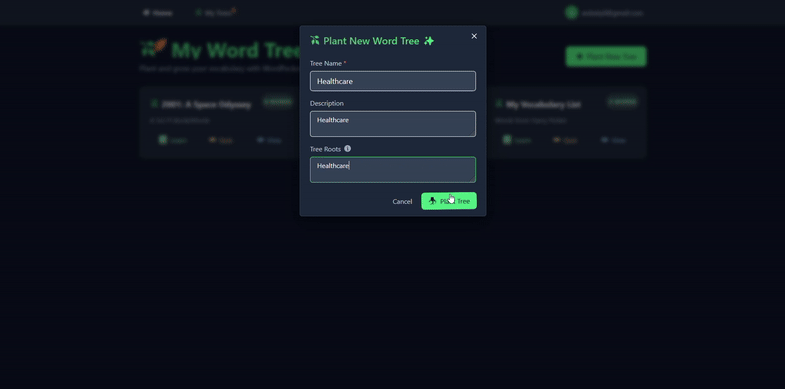With the rapid development of artificial intelligence technology, language learning tools are undergoing an intelligent revolution. AIbase recently learned from online information that an open-source language learning application called WordPecker has attracted widespread attention. This tool not only integrates interactive course designs similar to Duolingo but also provides personalized vocabulary learning experiences and immersive voice interaction features through large language models (LLMs) and text-to-speech (TTS) technology.
Personalized Learning, Breaking Traditional Limitations
WordPecker is an open-source language learning tool that allows users to extract vocabulary from any content such as books, articles, or videos to create a personalized vocabulary list. Unlike traditional language learning apps, WordPecker enables users to choose their learning topics (such as "space exploration" or "cooking tips") and difficulty levels. The system generates vocabulary and learning content that matches the user's level through LLMs. AIbase found out that this app supports over 100 languages, including English, Spanish, and Chinese, making it especially suitable for learners who want to switch flexibly between multiple languages.

Users can quickly filter vocabulary through the "Know/Know Not" interface, and the system provides contextual definitions, example sentences, and visual aids based on user feedback to help build stronger memory associations. In addition, WordPecker supports generating reading materials related to the vocabulary, allowing users to reinforce their learning in real contexts. This highly personalized design significantly enhances learning efficiency and enjoyment.
Speech Agent, Opening Immersive Dialogue
One of the most prominent features of WordPecker is its speech interaction function. By integrating OpenAI's speech agent technology, users can have real-time voice conversations with an AI language tutor to practice pronunciation, ask questions, and receive immediate feedback. This "24/7 language partner" experience makes users feel as if they are in a real language exchange scenario. AIbase noticed that the speech agent can customize conversation content based on the user's vocabulary list and support dynamically adding new words during the conversation, further enriching the learning experience.
For example, users can engage in conversations with the AI tutor around a vocabulary list on the topic of "travel," practicing related expressions and correcting pronunciation errors. Thanks to TTS technology, the generated speech by WordPecker is natural and smooth, supporting various languages and accents (such as American English, British English, and Chinese Mandarin), providing users with a learning environment close to native speakers.
Diverse Learning Modes, Meeting Different Needs
WordPecker offers multiple learning modes, including interactive quizzes, reading exercises, and voice practice, allowing users to choose according to their preferences. Quiz mode includes five types of questions: multiple choice, fill-in-the-blank, matching, etc., all of which can be customized in difficulty and content. Reading exercises involve AI-generated articles containing target vocabulary to help users understand and remember words in context. Additionally, users can use the "Context Exploration" feature to learn the meanings and usage of the same word in different scenarios, deepening their understanding.
AIbase learned from community feedback that WordPecker's visual integration feature is also popular. The system generates relevant images for vocabulary, helping users strengthen learning through visual memory. For example, when learning "galaxy," the system may display an image of a galaxy, combined with example sentences and pronunciation practice, creating a multisensory learning experience.
Open Source Advantages, Community-Driven Innovation
As an open-source project, WordPecker's source code is hosted on GitHub, allowing developers to freely modify and optimize it. AIbase found out that the project has been iterated several times since its initial release in 2024. The latest version optimized the backend architecture, switched to a MongoDB database, and used the OpenAI Agent SDK to restructure the voice functionality, improving the system's stability and usability. Community developers also plan to introduce local TTS models (such as XTTS-v2 or MeloTTS) to reduce dependency on external APIs and support more languages and commercial scenarios.
Although some functions of WordPecker currently rely on OpenAI's voice API, the development team says they are exploring lightweight solutions, such as KoboldCPP, for local image generation and TTS support. This will further reduce costs and benefit more users. AIbase believes that WordPecker's open-source nature gives it strong community-driven momentum and it is expected to achieve more functional breakthroughs through contributions from global developers in the future.
The Intelligent Future of Language Learning
The emergence of WordPecker marks the deep application of AI technology in the field of language learning. Its innovative design combining LLMs and TTS not only enhances the personalization and interactivity of learning but also lowers the technical barrier through an open-source model. AIbase predicts that as voice interaction and multimodal learning technologies mature further, tools like WordPecker will become the mainstream choice for language learning, providing users with more efficient and natural immersive experiences.
For users who want to try WordPecker, they just need to visit its GitHub repository to get the installation package and set up an API key to start learning. Whether students, professionals, or language enthusiasts, this tool is worth trying. AIbase will continue to follow the update dynamics of WordPecker and bring more cutting-edge information to readers.
Project Address: https://github.com/baturyilmaz/wordpecker-app?tab=readme-ov-file
